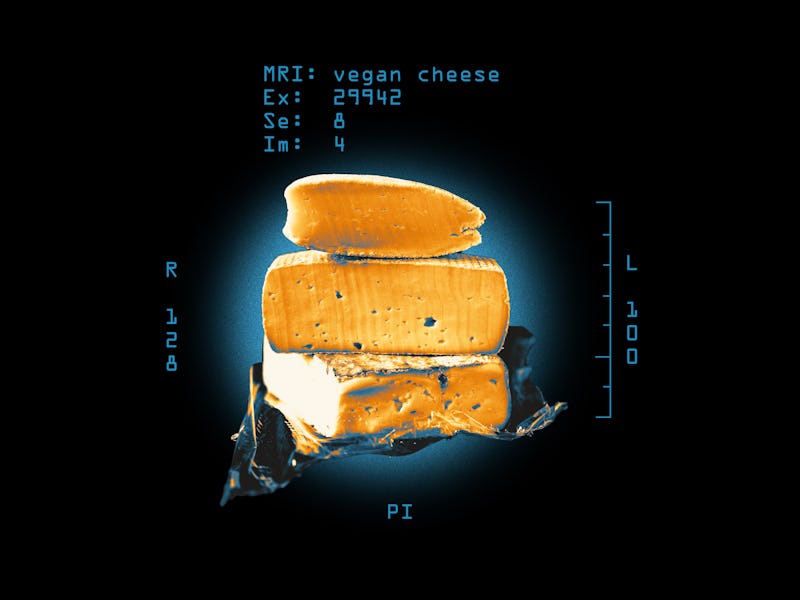Why Vegan Cheese's Worst Quality May Be "Impossible" To Solve
Getting the stringy, gooey product just right is a bit of a scientific mystery.

Cheese pulls are their own category of food porn. It’s not enough to savor a mozzarella stick — first, you must break and draw it apart like delicious, greasy Silly Putty. If we feast with our eyes first, then we skip an entire meal by leaving out a slow, sensual cheese pull.
So it’s not surprising that meltability and gooeyness are a priority when it comes to making vegan cheeses. Unsurprisingly, this characteristic is also one of the hardest to replicate in non-dairy cheeses. The demand for these products has markedly increased: Over the last two years, sales of plant-based foods increased 53 percent. As appetite for vegan dairy alternatives grows, consumers search for animal-free versions that deliciously ooze like the real thing. So far, though, vegan cheese doesn’t really melt. The reason behind this discrepancy is all in its chemistry.
What makes dairy cheese melt?
Cheese’s underlying chemistry enables its mouthwatering pull, B. Pam Ismail, a professor of food chemistry at the University of Minnesota and the director of its Plant Protein Innovation Center, tells Inverse.
Cheese comes from milk, which is a stable mixture of fats, proteins, and carbohydrates in water. To make many types of cheese, manufacturers will add an enzyme to the milk, which triggers coagulation, or curdling, where proteins found in milk called casein micelles fall out of the stable mixture and clump together. As the milk curdles, Ismail says, phosphate groups and calcium (found abundantly in milk) form calcium phosphate bridges that link the casein micelles together. When the curdling process is complete, cheesemakers separate the whey (a liquid byproduct from the curdling process) from the casein.
When you heat the resulting cheese up, those calcium phosphate bridges weaken. The result is a cheese pull, which is basically a slip n’ slide for micelles and fats.
A cheese’s moisture levels, acidity, and fat content can all influence how stretchy it becomes, which is why some cheeses are meltier than others. For example, micelles in high-acid cheeses, like feta, clump together and don’t separate much when they’re heated. Low-acid cheeses, like queso fresco and brie, aren’t great melters because their high calcium content keeps the micelle bonds in tact. Cheeses that melt just right, like mozzarella and cheddar, fall in the middle.
Why doesn’t vegan cheese melt?
Plant proteins, on the other hand, have a completely different amino acid composition than milk proteins. These proteins vary depending on whether they’re made from soy, pennycress, nuts, or another source, but the key is that they will never imitate casein.
To make vegan cheese, manufacturers sometimes start with plant-based milk and add a formulation that can include starches, vegetable fats, proteins, and stabilizers. The end result is also a stable mix of these ingredients that somewhat resembles cheese. But when heated, the stable mixture softens rather than melts because there are no casein micelles to create this stretchy slip n’ slide.
“You will never get the same kind of texture and taste as dairy cheese,” Ismail says.
Which vegan cheese melts the most like dairy cheese?
Alas, Ismail didn’t have a satisfying answer. In fact, she recommended that we begin to move away from associating plant-based proteins with animal products entirely, simply because they will never compare.
“Let's make new types of food products that are just plant-based products,” she says. “We don't have to call them cheeses, we don't have to call them meats.” Labeling a plant-based protein as cheese will immediately give consumers an expectation that cannot be reached.
“As soon as you say the word cheddar or cream cheese, the consumer is going to associate it with dairy experiences,” she tells Inverse. These plant proteins have their own unique flavors and applications.
So, if you are craving a mozz stick with a great cheese pull, Ismail says that’s a good enough reason. “If you love cheese that much, just eat the dairy cheese.”
Editor’s Note: This story has been updated to further define the cheese-making process and its connection to how cheese melts. It has also been updated to correct the name of B. Pam Ismail. A previous version of the story had her name as Pamela Ismail. We are glad to correct this error.